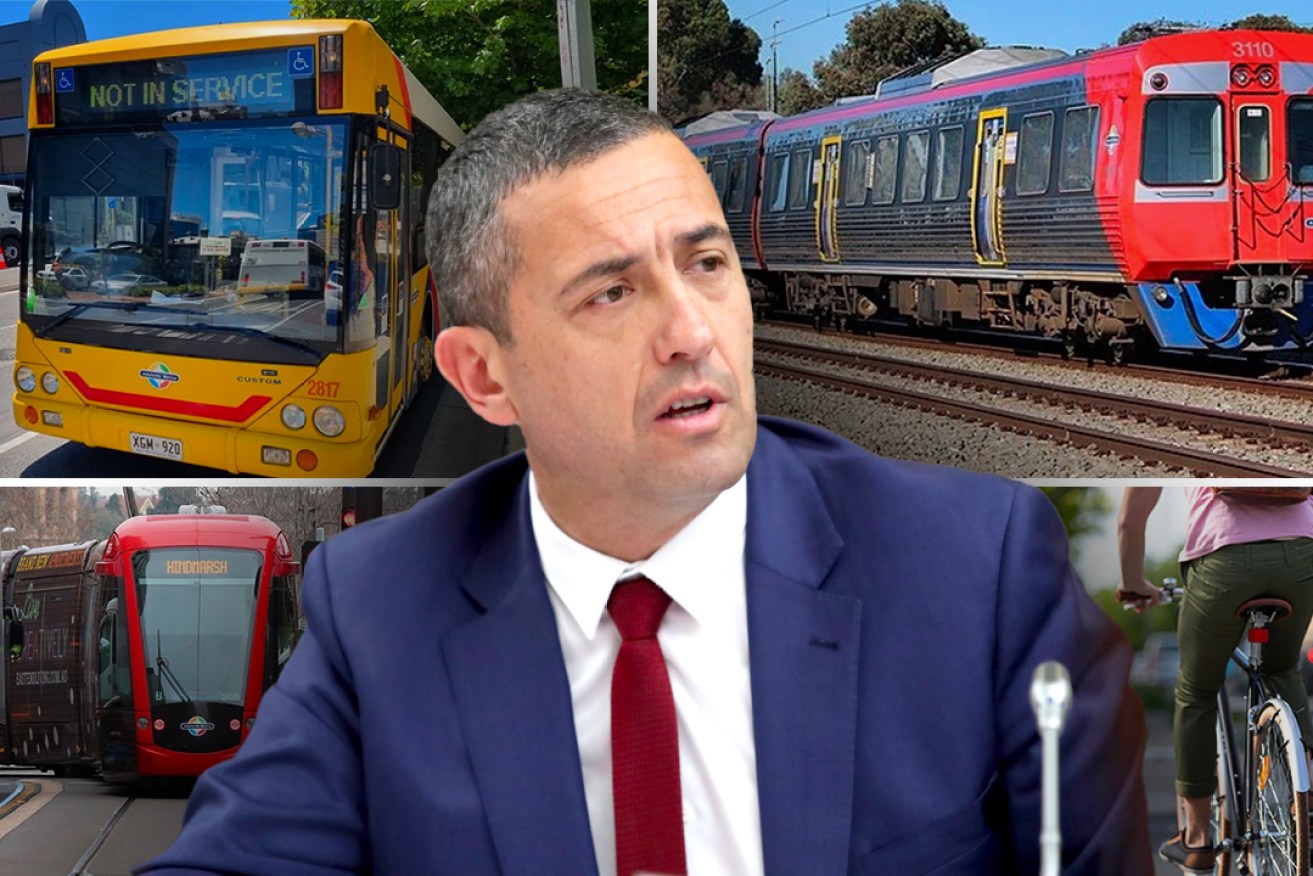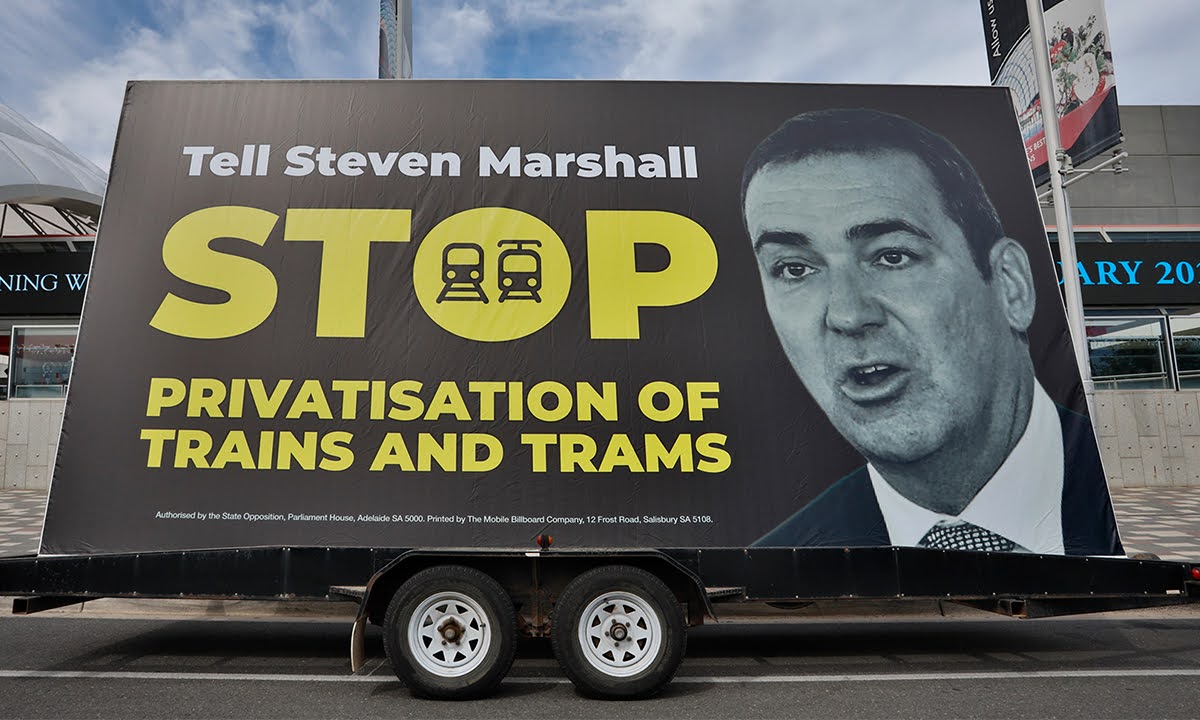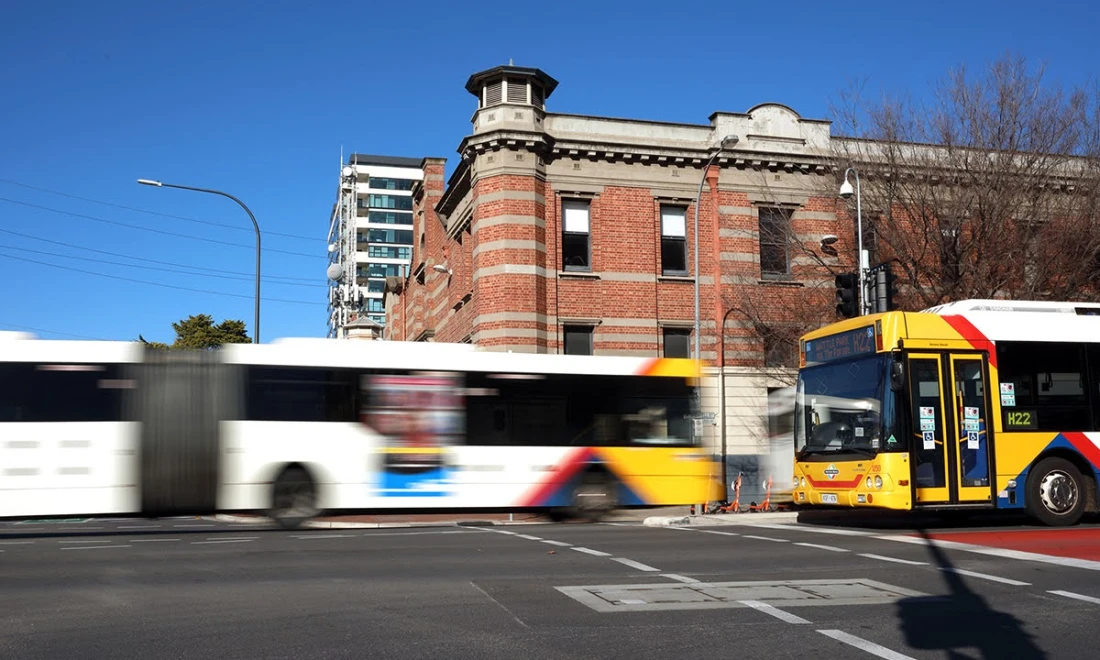Can Koutsantonis fix Adelaide’s public transport?
On-demand buses in Adelaide’s suburbs, unravelling privatisation, “tap and go” payment on all services – Transport Minister Tom Koutsantonis insists he has a big public transport agenda for the city. But can it be delivered and, if so, when?


Photos: InDaily/Image: Tom Aldahn/InDaily
Public transport is in trouble in Adelaide.
Passenger numbers have plummeted through the pandemic years and, despite restrictions being lifted, the latest statistics show it will take something out of the ordinary for patronage to return to anywhere near where it once was.
Data provided to InDaily by the Department for Infrastructure and Transport shows that while patronage improved in the second half of 2022 – from 130,000 people using Adelaide Metro services each weekday in February, to about 180,000, early this year – it still represents a 24 per cent drop across the network compared to pre-COVID levels.
A quarter of public transport users have disappeared from the system since early 2020 and South Australians will need patience before they see many significant changes to their services.
Minister Tom Koutsantonis tells InDaily he has a plan to fix this decline, but he’s taking a longer view on when the key elements will be delivered.
He has history in the portfolio: he was Transport Minister for a time during the Weatherill era but, oddly, didn’t have primary responsibility for public transport. That fell to Transport Services Minister Chloe Fox in a portfolio divide that he now says was a mistake.
“I thought there was a big disconnect when that occurred – I thought that was a mistake separating those portfolios out,” he told InDaily in an interview at his city office.
“I’ve been thinking a lot about public transport and how to improve it.”
Despite Adelaide’s record as one of the most car-centric capital cities in Australia, Koutsantonis believes the city is prepared to pay for the investment needed to produce a public transport system that is “quick, efficient, safe and clean”.

The new Government is promising to kill the ‘privatisation’ of trains and trams – but it hasn’t pulled it off yet.
His plan for improving all of these measures begins with unravelling the private management of the system including, he says, a close look at whether the government can unpick the decades-old privatisation of the bus system.
First, though, is Labor’s election promise to cancel the previous Government’s contract with transport giant Keolis Downer to manage Adelaide’s passenger trains. The trams were also privatised under the Marshall government in 2020, and are run by the Torrens Connect consortium, with an eight-year contract connected to a bus contract.
“So the first priority is I’ve got returning trains and trams, getting (them) back into back into (government) control,” Koutsantonis told InDaily. “And then dealing with the public transport system as one organism rather than separate streams, which are all dealt with almost in silos. And how do you actually then grow the patronage?”
In Opposition, Labor promised an inquiry within 100 days about returning the rail services to public hands. That’s morphed into a protracted negotiation, with the head of Koutsantonis’s department last year saying that the Government didn’t necessarily need to break the contract to end the arrangement.
Koutsantonis isn’t giving too much away about the status of the protracted negotiations, but says they “are going exceptionally well” and insists the services will be returned to public management, without any payment of compensation.
A Departmental investigation of the whole issue, including the far trickier proposition of unpicking the bus privatisation which dates back to the turn of the century, will be delivered to the Minister “in the first half of this year”, according to his office.
The current bus operators are only three years into eight-year contracts (with options for a two-year extension), but Koutsantonis appears to believe fervently that these services, too, should and can be back placed in public hands. In relation to buses, that seems an unlikely prospect, but he rejects arguments that private management has led to better services and efficiencies.
“The value of the service we pay implies there’s a profit gap, right, that the proponents who are running our services are making for their investors,” he says. “That could be in between as much as $5 million to $15 million or $20 million a year.”
Curiously, the one legacy of the previous Government’s public transport agenda that Koutsantonis is keen to expand involves a privately-managed service – the Keoride on-demand buses being trialled in the Adelaide Hills and the Barossa.
The smaller buses, run by current train operator and Hills bus contractor Keolis Downer, can be ordered on-demand via an app in the growth areas they serve.
Koutsantonis would like to see the service expanded beyond outer metropolitan areas to the suburbs of Adelaide.
“I think it’s worked exceptionally well,” he said. “I reckon there’s potential for us to do more of that… Where can we expand that in metropolitan Adelaide? These are the questions that the department are trying to solve for me, as we speak.”
Empty buses in non-peak times are one of his bugbears and he believes on-demand services can help fix that.
“A modern public transport system needs to do a lot of things, but what it can’t do is move air around, which is what we’re doing.”

We can’t “move air around” with empty buses in non-peak times, says Tom Koutsantonis. Photo: Tony Lewis/InDaily
Beyond that, though, the Minister’s vision is incremental, but he’s convinced the whole of his vision is greater than the sum of its parts, and begins with basics like smarter stop positioning, improved quality of buses, easier ticketing, simpler timetables, more bus priority measures to ensure speedier journeys, and improved safety.
“My thinking is – we bring trains and trams back, and start looking at what is the value proposition for someone who wants to catch public transport into the city. How far will someone walk or drive to catch a train? How far will someone walk or drive to catch a tram? How far will someone walk or drive to catch a bus? Why is it that trams and trains and the O-Bahn are more popular than your normal bus services that operate on roads? I think the answer is pretty obvious: it’s that dedicated lines are quicker. I don’t have a fixed view, but we’ve got to work out a way of moving buses a lot faster through very congested pieces of road.”
Interestingly for someone who has presided over a review of the North-South corridor road project which has seen the cost of the final section blow out to a huge $15.6 billion, the Minister believes public transport provides much more bang for buck than road projects.
He says “it’s an economic no-brainer to start investing more heavily in public transport”.
Yet, despite that, he’s not promising any significant investment in the short term.
Expanding the tram network, for example, is off the agenda.
“We took (the tram expansion) to the election… but that was comprehensively rejected by the public. I think the public liked the idea of trams – they don’t necessarily want to pay for the rollout and it would be a very expensive exercise.” Also, he reckons voters “won’t come at the tram line extensions because of the inconvenience they believe it causes them while they’re driving”.
Chicken and egg.
So what is the Malinauskas Government prepared to do to increase patronage on the public transport system?
For a start, Koutsantonis wants to fix what he sees are inefficiencies and annoyances in the network, particularly the bus system.
“Simplification of the entire system”, including Adelaide Metro timetables, and a more streamlined user experience generally, is front and centre.
“I mean, I go to the Adelaide Metro website and try and find route maps. For buses, it’s not easy. It’s not an easy system to use.”
He also believes a simpler payment system is also a no-brainer, with his aim to expand “tap and go” trials to all public transport services.
“We’ve got this terrible system, where you’ve got to go charge an Adelaide Metrocard to get on a bus. And it just doesn’t work properly. So this tap and go would change a lot of that.”
Any one piece of major infrastructure on a road network would exceed that entire operational cost of the public transport service. So it makes sense to have people catching public transport
“Tap and pay” with a credit card is available on O-Bahn and tram services, but Koutsantonis wants it rolled out across the whole system, with smart technology built in so it can recognise and reward regular users.
He’s even pondering radical steps such as having the reader outside the bus: tap your card and the doors open. A move to allow people to enter the bus by the centre door has made the system quicker, but it’s also increased fare evasion, something he’s keen to reduce.
“We’ve got to work out a way of getting people paying for the tickets, getting on a bus and getting on and off quickly without compromising amenity and speed,” he said.
“So this is what I’ve asked the department to go away and look at. I want them to come up with a system where if I’ve never caught public transport before in my life, I can look at an app and easily understand where I have to go, what bus train or tram I need to get on to go to where I want to go, without having to go forward and fill in four forms in triplicate, get an Adelaide Metro card, whatever it might be.”
Cleaner buses, inside and for the environment, are also part of the vision.
“If you drive around the city in the middle of the day, our buses are very loud, noisy and don’t produce a good level of amenity in the CBD.
“Electrification of these services is potentially a game-changer. We won’t buy any more diesel buses ever again: from now it’s either hybrid or electric or hydrogen fuel cell.”
But the open question is when passengers will see any of these changes.
Koutsantonis told InDaily there was not likely to be any significant new spending on public transport in the next year.
“Not necessarily in this upcoming budget, but over the life of the government absolutely,” he said.
He is adamant, though, that Adelaide’s public transport system won’t enter what transport planners call a death spiral: where falling patronage leads to dropping public investment, which further drives down passenger numbers.
“No, we want to grow it. Any one piece of major infrastructure on a road network would exceed that entire operational cost of the public transport service. So it makes sense to have people catching public transport.”
He quickly adds that that doesn’t mean road projects will no longer be funded, nor does he see any policy setting to coerce the public onto buses, trains and trams.
“The only way it’s going to work is if we offer them a quick, clean, good service that saves them money.
“In metropolitan Adelaide, there’s a big opportunity for us to dramatically increase patronage, because from the reports I’ve seen – you know, given the way modern insurance charging works, given the cost of fuel, cost of car parking – it is economic to catch public transport.
“But we’re not making the case well enough. And there are a number of reasons. It could be amenity – people in their cars stuck in traffic alongside the same bus that’s stuck in traffic. They’re thinking: I could be on that bus or in my car – so they choose their car. Are the routes frequent enough, or bus stops close enough? Are the stops good enough? So there needs to be a holistic approach to how do we improve all these services.”
Most of these questions are still open in his mind, awaiting department advice and investigation.
The question is: what state will the system be in by the time any changes happen?
In part two tomorrow: the future or regional public transport and cycling.




